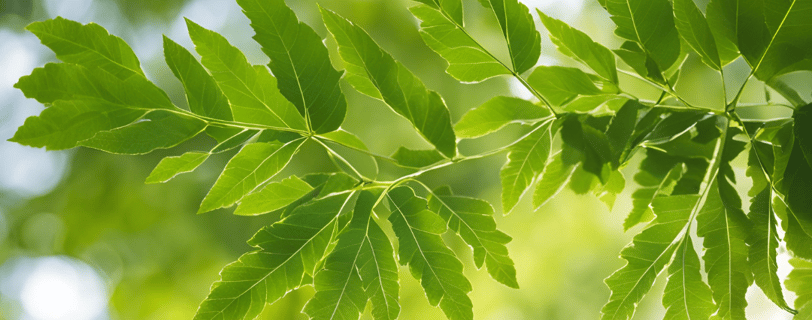The Miraculous Neem Tree: Nature's Pharmacy
Discover the incredible benefits of the neem tree (Azadirachta indica), a natural powerhouse for both health and the environment. Revered in Ayurvedic medicine for centuries, neem’s leaves, bark, seeds, and flowers are packed with antibacterial, antifungal, and anti-inflammatory properties that treat skin conditions, boost immunity, and promote oral health. Beyond its medicinal uses, neem plays a crucial role in sustainable farming, acting as a natural pesticide, enriching soil fertility, and supporting biodiversity. Explore how this versatile tree offers a holistic solution for wellness and environmental sustainability.
A GUIDE TO NATURAL REMEDIES
Mr.9
9/23/20245 min read


Introduction to the Neem Tree
The neem tree, scientifically known as Azadirachta indica, is a remarkable evergreen tree that holds a significant place in various cultures, particularly in India. It is commonly referred to as the "panacea for all diseases," illustrating its importance in traditional medicine and its wide range of applications. The neem tree is indigenous to the Indian subcontinent but has adapted well to diverse climates, thriving in semi-arid and tropical regions across the globe. Its ability to grow in poor soil conditions makes it a suitable species for reforestation and sustainable agricultural practices.
Cultivated for thousands of years, the neem tree has been revered for its medicinal properties. In Ayurveda, the ancient Indian system of medicine, different parts of the neem tree are utilized for their health benefits, including leaves, bark, seeds, and oil. These components are traditionally used to treat a variety of ailments, such as skin disorders, fever, and digestive issues, highlighting the tree's role as a natural remedy. The versatility of the neem tree in supporting health and wellness has garnered attention in both traditional and modern contexts, leading to its increasing relevance in contemporary herbal medicine.
Moreover, the neem tree plays a crucial role in promoting environmental health. It is known for its natural pest-repelling abilities, acting as a natural pesticide, which reduces the dependence on chemical alternatives in agriculture. Additionally, the tree contributes to soil fertility and erosion control, making it invaluable for sustainable farming practices. Its ability to sequester carbon also highlights its importance in combating climate change. As global interest in natural alternatives to synthetic chemicals grows, the neem tree stands out as a champion of both health and environmental sustainability.
Leaves
The leaves of the neem tree are perhaps its most renowned component, characterized by their glossy green appearance and distinct serrated edges. Known for their potential therapeutic properties, neem leaves are frequently used in traditional medicine. They contain a plethora of bioactive compounds, including azadirachtin, which is lauded for its antibacterial and antifungal properties. Infusions made from these leaves are often applied topically to treat skin ailments such as acne, eczema, and psoriasis. Additionally, neem leaf extracts are consumed in various forms to promote overall health, serving as a natural remedy for fevers and digestive issues.
Bark
The bark of the neem tree exhibits a rugged texture, featuring a grayish-brown color with a rough surface. It is rich in compounds such as nimbidin, which is credited with numerous medicinal benefits. Traditionally, neem bark has been employed in Ayurveda as a natural antiseptic and anti-inflammatory agent. It is often used in the form of powdered supplements or decoctions. The bark’s natural properties are believed to assist in oral health as well, with topical applications contributing to the healing of gums and teeth.
Seeds
Neem seeds, contained within small, oval-shaped fruits, play a crucial role in the propagation of the tree. Once extracted, these seeds can be pressed to release neem oil, which is celebrated for its versatility and numerous health benefits. Neem oil is recognized as a powerful insect repellent and is widely used in organic pest control. In addition, it is often incorporated into cosmetic products for its hydrating and anti-aging properties. The seeds themselves also contain valuable nutrients and can be used in various formulations to support skin health and promote healing.
Flowers
The small, white to yellow flowers of the neem tree emit a subtle, sweet fragrance and are essential for the tree’s reproduction. Rich in essential oils, these blossoms possess anti-inflammatory and antimicrobial properties, thus making them beneficial in traditional herbal remedies. Additionally, neem flowers are often brewed into teas or included in skincare formulations for their soothing effects. Their potential to enhance health extends to being an aphrodisiac in some cultures, showcasing the breadth of traditional uses attributed to all parts of the neem tree.
Medicinal Uses and Remedies of Neem
The neem tree, often referred to as nature's pharmacy, boasts a multitude of medicinal properties that have been utilized for centuries in various cultures. Its parts, including leaves, bark, and oil, are rich in bioactive compounds that provide numerous health benefits. One of the most notable uses of neem is in skin care. Neem leaves can be crushed and turned into a paste, which can be directly applied to acne-prone skin. This paste helps reduce inflammation and prevents further breakouts due to its antibacterial properties. For enhanced effects, a few drops of neem oil can be added for a more potent remedy.
In terms of oral health, neem twigs, often used as natural toothbrushes, have been proven to combat plaque and prevent gum disease. Chewing on neem twigs helps reduce oral bacteria, contributing to better overall dental hygiene. Alternatively, a mouthwash can be created by boiling neem leaves in water and then gargling the cooled solution, effectively addressing bad breath and maintaining oral freshening.
Furthermore, neem is revered for its ability to manage common ailments such as fevers, infections, and digestive issues. A traditional remedy for fever includes preparing a neem tea by boiling neem leaves in water. This tea, when consumed twice daily, can help reduce fever symptoms. Additionally, for gastrointestinal problems, neem bark decoction can be made by boiling the bark in water. This decoction aids in digestion and alleviates issues like bloating and gas.
Several testimonials highlight neem's effectiveness, with individuals reporting significant improvements in skin conditions and overall well-being after incorporating neem remedies into their health regimens. With its extensive range of applications, it is evident that incorporating the neem tree into daily health practices offers a natural and effective approach to wellness.
The Environmental Benefits of Neem
The neem tree, scientifically known as Azadirachta indica, serves as a vital component in maintaining ecological balance and promoting sustainable agricultural practices. One of its most noteworthy contributions lies in its role in pest management. The natural compounds found in neem leaves and seeds, such as azadirachtin, have been extensively researched for their insect-repelling properties. These compounds disrupt the reproductive cycles and feeding patterns of various pests, making neem an effective alternative to chemical pesticides. By employing neem in organic farming, farmers can reduce their dependency on synthetic chemicals, thereby minimizing environmental degradation.
In addition to pest management, neem significantly contributes to soil health. The leaf litter from neem trees enriches the soil with organic matter as it decomposes, thus improving soil structure and fertility. This nutrient-rich environment further supports microbial activity, essential for maintaining balanced soil ecosystems. Farmers who incorporate neem trees into crop rotations benefit from improved soil quality, leading to higher yields and sustainability in their agricultural practices. This symbiotic relationship demonstrates the potential of neem to act as a natural enhancer in soil and crop management.
Furthermore, the neem tree promotes biodiversity in ecosystems. Its broad canopy offers habitat for various bird species, beneficial insects, and other wildlife, fostering a balanced ecosystem. The cultivation of neem can support polyculture farming, where multiple crops are grown in harmony, enhancing resilience against pests and disease while diversifying food sources. For instance, many farmers in countries like India and Africa have successfully integrated neem into their agricultural systems, reporting increased biodiversity and healthier crops. The holistic advantages provided by the neem tree underscore its critical role not just in individual health, but in the broader context of environmental preservation and sustainability.


Herbs
Explore nature's wisdom through our herbal blog.
Connect
Discover
herbalharitage9@gmail.com
© 2024. All rights reserved.
Quick Links
